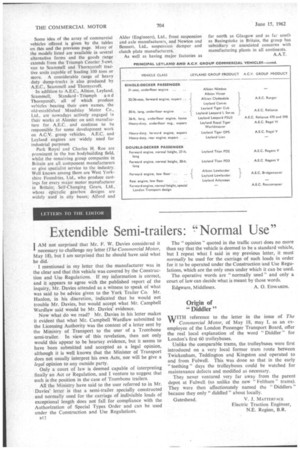Extendible Semi-trailers: ‘-`Normal Use"
Page 46

If you've noticed an error in this article please click here to report it so we can fix it.
I AM not surprised that Mr. F. W. Davies considered it I necessary to challenge my letter (The Commercial Motor, May 18), but I am surprised that he should have said what he did.
I mentioned in my letter that the manufacturer was in the clear and that this vehicle was covered by the Construction and Use Regulations. If my information is correct, and it appears to agree with the published report of the inquiry, Mr. Davies attended as a witness to speak of what was said to be advice given to the York Trailer Co. Mr. Hanlon, in his discretion, indicated that he would not trouble Mr. Davies, but would accept what Mr. Campbell Wardlaw said would be Mr. Davies' evidence.
Now what do we read? Mr. Davies in his letter makes it evident that what Mr. Campbell Wardlaw submitted to the Licensing Authority was the content of a letter sent by the Ministry of Transport to the user of a Trombone semi-trailer. In view of this revelation, then not only would this appear to be hearsay evidence, but it seems to have been submitted and accepted as a legal opinion, although it is well known that the Minister of Transport does not usually interpret his own Acts, nor will he give a legal opinion to any outside party.
Only a court of law is deemed capable of interpreting finally an Act or Regulation, and I venture to suggest that such is the position in the case of Trombone trailers.
All the Ministry have said to the user referred to in Mr. Davies' letter is that a semi-trailer specially constructed and normally used for the carriage of indivisible loads of exceptional length does not fall for compliance with the Authorization of Special Types Order and can be used under the Construction and Use Regulations. The " opinion " quoted in the traffic court does no more than say that the vehicle is deemed to be a standard vehicle, but I repeat what I said in my previous letter, it must normally be used for the carriage of such loads in order for it to be operated under the Construction and Use Regulations, which are the only ones Under which it can be used.
The operative words are "normally used" and only a court of law can decide what is meant by those words.
Edgware, Middlesex. A. 0. EDWARDS.
Origin of " Diddler "
ITH reference to the letter in the issue of The Commercial Motor, of May 18, may I, as an exemployee of the London Passenger Transport Board, offer the real local explanation of the word " Diddler " for London's first 60 trolleybuses.
Unlike the comparable trams, the trolleybuses were first introduced on a very local former tram route between Twickenham, Teddington and Kingston and operated to and from Falwell. This was done so that in the early " teething " days the trolleybuses could be watched for maintenance defects and modified as necessary.
They never ventured very far away from the parent depot at Falwell (so unlike the new " Feltham " trams). They were then affectionately named the " Diddlers " because they only " diddled " about locally.
Gateshead. V. J. MATTERFACE Electric Traction Engineer, N.E. Region, B.R.




















































































































